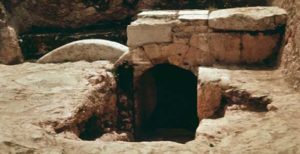Luke 24:5b-91NIV New International Version Translations
5b “Why do you look for the living among the dead? 6 He is not here; he has risen! Remember how he told you, while he was still with you in Galilee: 7 ‘The Son of Man must be delivered over to the hands of sinners, be crucified and on the third day be raised again.’ ” 8 Then they remembered his words. 9 When they came back from the tomb, they told all these things to the Eleven and to all the others.Matthew 28:6-7
6 He is not here; he has risen, just as he said. Come and see the place where he lay. 7 Then go quickly and tell his disciples: ‘He has risen from the dead and is going ahead of you into Galilee. There you will see him.’ Now I have told you.”
 Background
Background
The challenging and quintessential question in this story is that of the messenger(s) in the tomb, “Why are you looking for him who is alive among the dead?” Many of us still go looking for Jesus among the dead. There are those who regard Jesus as the greatest man and the noblest hero who ever lived, as one who lived the loveliest life ever seen on earth; but who then died. That is not the description you should ever accept. Jesus is not dead, He is alive. He is not merely a hero of the past but He is a living reality of the present. And that reality is what Easter is all about!
First, lets dispose of a few Scriptures discrepancies. We find it in the accounts of the resurrection of which the opponents of Christianity seem to make so much about.
- In Mark the messenger in the tomb is a young man in a long white robe (Mark 16:5);
- In Matthew he is the angel of the Lord (Matthew 28:2).
- In Luke 24:4, it is two men in bright white robes;
- and in John it is two angels (John 20:12).
Matthew’s version of the resurrection story, including the women’s experiencing an earthquake and seeing the angel descend, roll away the stone, and sit on it. The guards quake with fear at the events unfolding before them. Matthew also identifies the first people to hear the news of the resurrection. In other Gospels, the stone is already rolled back when the women and witnesses arrive at the tomb.
In the east tombs were often carved out of caves in the rock. The body was wrapped in long linen strips like bandages and laid on a shelf in the rock tomb. The tomb was then closed by a great circular stone like a cart-wheel which ran in a groove across the opening. The groove sloped downwards so that to roll the stone back and open the tomb would take a team of people, no simple task. We also find documented in Matthew:
- A rich man of Arimathea, named Joseph, also a follower of Jesus went to Pilate and received the body.
- Joseph wrapped the body in a clean linen cloth and laid it in his own new tomb where he rolled a great stone to the door of the tomb, closing it and then departed.
- The next day, the chief priests and Pharisees came to Pilate and were concerned of Jesus’s claim of resurrection in three days.
- Pilate commanded the tomb be made secure until the third day. Roman guards were posted until the women showed up.
It is true that there are differences in the Gospels. However, it is also true that, whatever the description is of who is in the tomb when the women show up, the basic fact is they find the tomb empty. Jesus is gone. No two people ever described the same dramatic event in the same terms. This is no doubt true of the resurrection. The heart of this story is the all-important fact that Jesus is not in the tomb. The women returned with their story to the rest of the disciples but disciples refused to believe them, calling it an idle tale. The word used is one employed by Greek medical writers to describe the babbling of a fevered and insane mind. Only Peter went out to see if it might not possibly be true.
We need to stop for a second and consider Peter himself, the man who was a fearful person on the way to become a rock upon which Jesus would build His Church. The story of Peter’s denial of Jesus was not something that could have been kept silent. Those around Peter knew that story. Yet he had the moral courage to face those who knew of his prior cowardness. So Peter was both a coward and a hero. Peter was the first of the disciples to go to the tomb and see for himself.
The angel’s first words, expressed with a present imperative in Greek, strongly contrast the guards with the women: “Don’t you be afraid,” or “As for you, stop being afraid.” The angel is commanding them to reject their current state of fear, for his news brings great joy: “I know that you are looking for Jesus the crucified one. He is not here, for He was raised just as He said.” The resurrection has already happened. The stone has been rolled away not to let Jesus out, but to let the witnesses in. The angel sends the women to give the good news to the disciples, along with an additional message: Jesus is going ahead of them into Galilee, and they will see him there. The angel does not specify exactly which disciples the women are to tell or even single out Peter (compared to Mark 16:7).
The women immediately, “with fear and great joy” obey the angel’s command. Mark has them reacting with fear and silence, but in Matthew they run to announce the world-changing news. On the way, Jesus meets them and reiterates the angel’s command to stop being afraid. He is alive and present with them. Jesus has one final command for them: “go and tell my brothers to go to Galilee; there they will see me” (Matthew 28:10). If this was made into a movie, we would have a final scene where the eleven disciples are meeting with Jesus in Galilee, so at minimum Jesus is sending the women to tell the eleven. Given that one of the women is Jesus’ mother, it would be quite natural to assume that he means for her to tell James and Joseph and Simon and Judas as well (see 1 Corinthians 15:7, where Paul says that Jesus appeared to James). But are the women bearers of a message intended only for men?
It is important to point out that grammatically the Greek word translated as “brothers” could also be translated as “brothers and sisters.” Greek uses masculine plurals for any group that includes males, even if the group is comprised of nine women and one man. Though there are no women among the eleven, Matthew clearly includes women in the larger group of Jesus’ disciples. Furthermore, the shift in language from “disciples” to “brothers” recalls the scene in Matthew 12:46-40, where Jesus asks who His mother and brothers are and then answers His own question by saying, “Whoever does the will of my Father in heaven is my brother and sister (26:50).
Items for Discussion
- Of all you have heard or read in Scripture, your church, from others in your life, why do you believe that Jesus died on the Cross and in three days, rose from the dead?
- The angel’s message could be called the “First Easter Sermon.” Why do you think so many people still do not believe it? Why should they believe this Easter’s Sermon?
- What is the root of fear? Why do we fear something that we do not understand fully?
- How can we, the Church, overcome the world’s fear of death with the hope of resurrection? What do we need to do differently?
- Why is the resurrection and forgiveness, the Cross and the Empty Tomb, explicitly linked to our faith?
- What effect did Jesus have on not only His disciples but His followers when they finally understood and believed He was alive?
- If the acceptance of a Living Savior dramatically changes people, how can we help those around us come to that acceptance?
- What is the role of the Holy Spirit in Easter?
Discussion Challenge
- In a COVID-19 virtual world, how can we show Jesus is alive? That is what Jesus is waiting for!
- 1NIV New International Version Translations

